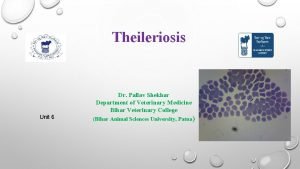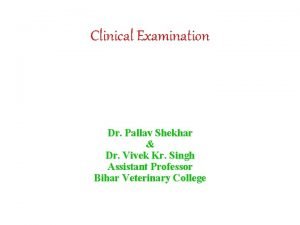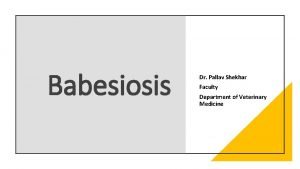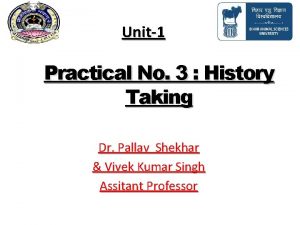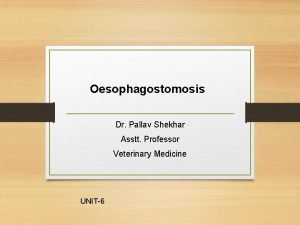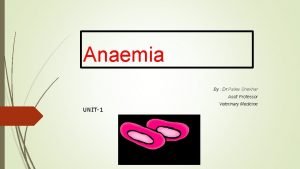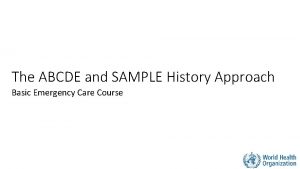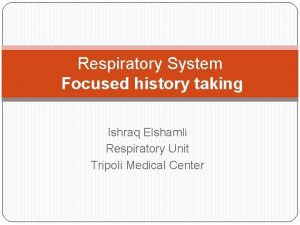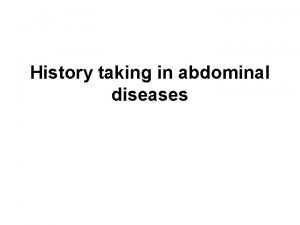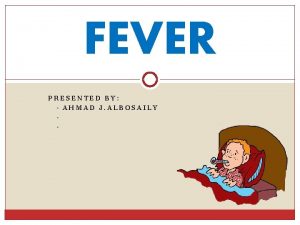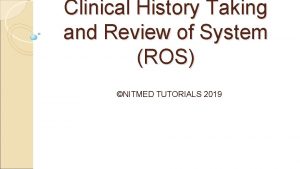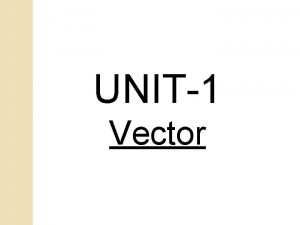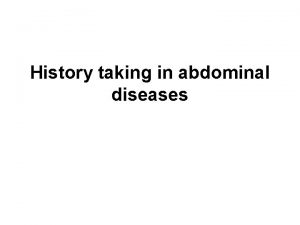Unit1 Practical No 3 History Taking Dr Pallav















- Slides: 15

Unit-1 Practical No. 3 : History Taking Dr. Pallav Shekhar & Vivek Kumar Singh Assitant Professor

HISTORY – TAKING (ANAMNESIS) • In veterinary medicine, history-taking is often the most important of the three aspects of a clinical examination • It is the key to accurate diagnosis in veterinary medicine • Failure to recognize the importance of the history can lead to error • To avoid being misled, it is essential that the veterinarian assesses the accuracy of the history by careful examination of what the owner relates about his/her animal

• The history should suggest not only the diagnostic possibilities but also the probabilities. • For exampleØ A one year old heifer is unlikely to have clinical johne’s disease Ø An adult cow is more likely to have parturient paresis/milk fever disease than a first calve heifer Ø A first-calf heifer is more likely to have maternal obstetrics paralysis than an adult cow

HISTORY-TAKING METHOD • Successful history-taking involves many veterinarian-client relationships • standard suggestion and /or guidelines that may prove useful to the clinicians • The clinician should introduce him /herself to the owner. How can I help you? Is an effective opening question, which provides the owner to relate his /her concern about the animal • The owner /attendant must be handled with diplomacy and tact

Cont… • Avoid the use of technical terms/terminology. It creates confusion • Statements concerned with time should be tested for accuracy • A good clinicians must try to separate owner’s observations from their interpretation. • The clinicians must know the right question, as this knowledge comes from experience and familiarity with the disease • A clinicians must establish the chronology of events

• For a complete and accurate historytaking the clinicians should a set of routine • Patient data • Disease history • Management history

Patient data • It includes: » » » Owner's name Postal address and telephone numbers Species type and breed, Sex, age Name or number, body weight Description of the animal- colour marking, polledness and other identifying marks of the patient

Disease history • • • Present Disease Morbidity Rate Case Fatality Rate Population Mortality Rate Prior treatment Prophylactic and control measures

Present Disease • Sequence of events associated with the period of time when then animal have been ill/sick • Important changes should be noted/ observed, viz. , intake of food or drink, milk production, growth, respiration, defecation, urination, gait, posture, voice and odor

Morbidity Rate • Percentage of animal – that are clinically affected compared with the total number of animals exposed to the same risk

Case Fatality Rate • Percentage of affected animals died Population Mortality Rate • Percentage of all exposed animals that die

Prior treatment • Detail information of preparations used and dosage given may be of value in • • Eliminating some diagnostic possibilities Assessing the probable efficacy of the treatment Significance of clinical pathological test In prescribing additional treatment

Prophylactic and control measures • A detail investigation regarding the use of some preventive and control measures should be ascertained like • • Any clinico-pathological test performed Artificial insemination to prevent veneral disease Recent deworming and vaccination Recent change in nutrition, management and hygiene

Management history • It includes • • Nutrition, Breeding policy and practice , Housing , Transport and general handling

Thanks
 The unforgettable history question and answer
The unforgettable history question and answer Dr pallav shekhar
Dr pallav shekhar Dr pallav shekhar
Dr pallav shekhar Dr pallav shekhar
Dr pallav shekhar Dr pallav shekhar
Dr pallav shekhar Dr pallav shekhar
Dr pallav shekhar Dr pallav shekhar
Dr pallav shekhar Dr pallav shekhar
Dr pallav shekhar History taking format
History taking format A b c d e
A b c d e Fever history taking
Fever history taking Pc hpc pmh dh
Pc hpc pmh dh Polypus vesicae felleae
Polypus vesicae felleae Thought content examples
Thought content examples Crapriop
Crapriop Odpara history taking
Odpara history taking

